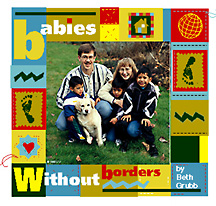

THE UNIVERSITY OF WASHINGTON ALUMNI MAGAZINE |

Part Two: The Boom in International AdoptionThe Knudsen and the Johnston-Bledsoe families are part of a burgeoning trend toward international adoption in this country. It began in the 1960s, when American families began to adopt Korean and Amer-Asian orphans. In the late '80s and early '90s, several factors contributed to a dramatic boom in the numbers of children adopted from other countries:
The numbers tell the tale: U.S. State Department records show that in 1991, just 62 Chinese children were adopted by American families and brought to the United States. Last year, there were 4,206 Chinese adoptees. During the same seven-year period, the number of international children adopted by Americans almost doubled, from 9,050 to 15,774. The current crisis in Kosovo has prompted hundreds of calls to the state department about the possibility of adopting war orphans, according to the Associated Press. But authorities discourage adoptions-at least for the next few months. "It's too early to tell if the children are truly orphans or are just temporarily separated from their families," U.N. refugee spokeswoman Jennifer Dean told AP. "We do not advocate for international adoption of refugee kids, but rather to reunite them with relatives so that they are in a safe, familiar environment." International adoption is complex, expensive and different in each country of origin. The process can cost up to $30,000 and consume as much as three years. The confusion and paperwork vary from country to country. And the U.S. medical community is just beginning to recognize that there is a gap between most pediatricians' knowledge and the needs of these families. Some of the early work in this area came out of the International Adoption Clinic at the University of Minnesota. In 1991 researchers there called for internationally adopted children to be routinely screened for hepatitis, tuberculosis, parasites, cytomegalovirus, HIV, retarded growth, hearing and vision problems and other medical conditions. Screening for these conditions was not common practice at the time. The Minnesota researchers tested 293 children adopted from overseas and found that 57 percent had at least one "important medical condition." Of these maladies, 81 percent were "silent diseases" not found by physical examinations, but by simple, non-invasive screening tests. Infectious diseases made up the majority (73 percent) of the conditions. More than a third of the medical problems could be corrected, the report concluded, and a failure to detect them might have entailed long-term consequences for the child or other family members. One common silent disease is hepatitis B. Worldwide, it is the most common chronic viral infection, affecting more than 300 million people, according Adoption Medical News, a newsletter for physicians practicing international adoption medicine. The virus is a major cause of death in regions where it is endemic. Over a lifetime, about one-third of chronically infected people die from hepatitis B or one of its complications, which include progressive liver disease, cirrhosis and hepatocellular carcinoma. The highest rates of infection are in Asia and Eastern Europe, especially Romania. Tests for hepatitis B done in a child's country of origin are highly unreliable, the newsletter states. Results are often false or confusing. To further complicate the issue, testing done outside the United States might actually cause children to be exposed to the virus or other blood-borne infections, such as HIV, because needles are often reused. |
Home / Current Issue / Archives / Talk Back / Advertising / Columns FAQ / Alumni Website / Search